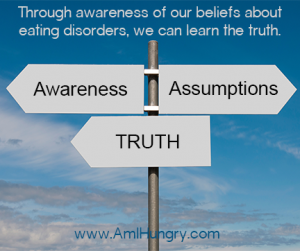 Minds love to categorize. They love to order things, make associations, and store information efficiently for easy retrieval, based on information provided through our experiences. This natural process of sorting incoming information confirms our conscious and unconscious beliefs about people, places, events, and things.
Minds love to categorize. They love to order things, make associations, and store information efficiently for easy retrieval, based on information provided through our experiences. This natural process of sorting incoming information confirms our conscious and unconscious beliefs about people, places, events, and things.
At a recent Binge Eating Disorder Association (BEDA) conference, we had several opportunities to explore beliefs about intersecting social identities. This quote from a leading eating disorder researcher, Cynthia Bulik (2014), stood out:
Eating disorders affect people of *ALL genders, ages, races, ethnicities, body shapes and weights, sexual orientations, and socioeconomic statuses. (*My emphasis.)
This means that the identities of people with eating disorders is much broader than the stereotyped images with which our minds might be more familiar. This also applies to the diagnostic crossover with eating disorders. People in higher-weight and lower-weight bodies can be diagnosed with, or suffer from subclinical characteristics of, anorexia nervosa (AN), bulimia nervosa (BN), and binge eating disorder (BED), and a diagnosis can change over time based on current behaviors.
In her white paper on BED, Binge Eating—Myths, Truths and Treatments, Dr. Kari Anderson (the co-author of Eat What You Love, Love What You Eat for Binge Eating) writes, “People with smaller-sized bodies who suffer from BED may engage in restricting behaviors or dieting for a longer period of time between binges or have smaller binges that do not result in weight gain. This does not mean they feel any less out of control and hate themselves any less. In fact, they may feel their disorder is minimized when in a group of women of size who also have BED.”
Current research on the broad social identities of people suffering with an eating disorder is slow to impact stereotypes, which are perpetuated in media images. Popular memes circulating on social media can be a source of division and inaccuracy by generalizing some eating disorder experiences, and may discount the experience of others.
Instead of making assumptions about people with eating disorders, we can:
- Look for resources that broaden our understanding of those who struggle in their relationship with food and eating.
- Explore how our conscious and unconscious Implicit) beliefs differ, allowing room for us to be curious about and question our assumptions about body size, weight, or shape. (You can learn about your own implicit biases here.)
- Seek to understand the perspectives of others and the social effect of living in a larger or smaller body.
Our awareness of our tendency to categorize is the first step. By recognizing the assumptions we make, we can join together to identify and treat eating disorders in ALL bodies.

6 thoughts on “Assumptions about Eating Disorders and Body Size”
hi
do you have any suggestions how to help someone an eating disorder such as anorexia
thank you
Hi Tamara,
Yes, getting an evaluation from a professional, trained in treating eating disorders, is the first step in treatment.
You can get more information from NEDA http://nedawareness.org/get-help.
Best to you.
Warmly,
Camerin
Tamara, please visit NEDA http://nedawareness.org/get-help.
Comments are closed.